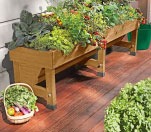Wooden cold frame greenhouses offer a stylish and functional solution for protecting plants and extending the growing season. These structures provide a controlled environment that shields plants from harsh weather conditions while adding a charming aesthetic to the garden or backyard. Here are some key benefits and considerations when it comes to wooden cold frame greenhouses:
Plant Protection: Wooden cold frame greenhouses provide an effective way to protect plants from cold temperatures, frost, wind, and other adverse weather conditions. The structure acts as a barrier, trapping heat and creating a microclimate that shields plants from external elements. This protection allows for earlier planting in the spring and extends the growing season in the fall.
Natural Aesthetic: Wooden cold frame greenhouses blend seamlessly into garden landscapes, adding a natural and rustic charm. The warm tones, texture, and grain patterns of wood create an inviting and organic feel, enhancing the overall aesthetic appeal of the greenhouse.
Durability and Insulation: Wood is a durable and insulating material, making it well-suited for cold frame greenhouses. High-quality wood, such as cedar or redwood, is naturally resistant to decay and can withstand outdoor conditions. Wood also provides excellent insulation, helping to maintain a stable temperature inside the greenhouse and protect plants from extreme cold or heat.
Customization and Design: Wooden cold frame greenhouses offer flexibility in design and customization. They can be built to suit specific dimensions, allowing you to adapt the structure to the available space and desired plant capacity. Additionally, wooden frames can be customized with features such as adjustable ventilation windows, removable panels, or shelves to accommodate different plant varieties and gardening needs.
Ventilation and Temperature Control: Proper ventilation is essential for maintaining a healthy and balanced environment inside the greenhouse. Wooden cold frame greenhouses can be designed with adjustable windows or vents to regulate airflow and control the temperature. This ventilation helps prevent overheating during warmer days and allows for adequate airflow to prevent fungal diseases and promote plant growth.
Sustainability: Opting for sustainably sourced or reclaimed wood for your cold frame greenhouse promotes environmental sustainability. By choosing responsibly harvested wood or repurposing existing materials, you contribute to the preservation of forests and minimize environmental impact.
Maintenance: Regular maintenance is necessary to ensure the longevity and functionality of a Wooden cold frame greenhouses. This may include applying protective finishes or treatments to the wood, inspecting for any signs of damage or wear, and replacing any worn-out or broken components. Proper maintenance will help keep the greenhouse in optimal condition and extend its lifespan.
Cost-Effective Option: Wooden cold frame greenhouse can be a cost-effective option compared to larger and more complex greenhouse structures. They require fewer materials and can often be constructed as a DIY project, saving on labor costs. However, it's important to consider the quality of the wood and construction to ensure durability and long-term value.
When planning for a Wooden cold frame greenhouses manufacturers, consider factors such as location, orientation for optimal sunlight exposure, and accessibility for maintenance and watering. Additionally, research the specific needs of your plants to ensure that the greenhouse environment provides adequate lighting, humidity, and temperature control.
Wooden cold frame greenhouses offer a blend of functionality, style, and plant protection. They create an inviting space for gardening enthusiasts to cultivate plants throughout the year, adding both beauty and functionality to outdoor spaces.

 0
0
 English
English 中文简体
中文简体 Français
Français Español
Español
















